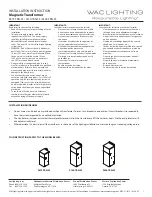
(TXDEV _ X 15)
dev
ref
f
f
TXDEV _ M
2
-
=
´
´
(TXDEV _ X 16)
dev
ref
f
f
TXDEV _ M
2
-
=
´
´
[
]
c
ref
f
9.8304
f
MHz
512
³
>
[
]
c
ref
f
9.8304
f
MHz
256
³
>
xosc
ref
f
f
REF _ DIV
1
=
+
c
ref
3
FREQ
0.5
DITHER
f
f
2
16384
+
´
æ
ö
=
´
+
ç
÷
è
ø
c
ref
3
FREQ
0.5
DITHER
f
f
4
32768
+
´
æ
ö
=
´
+
ç
÷
è
ø
SWRS046H – NOVEMBER 2006 – REVISED MARCH 2015
5.8
Frequency Programming
Programming the frequency word in the configuration registers sets the operation frequency. There are
two frequency words registers, termed FREQ_A and FREQ_B, which can be programmed to two different
frequencies. One of the frequency words can be used for RX (local oscillator frequency) and the other for
TX (transmitting carrier frequency) in order to be able to switch very fast between RX mode and TX mode.
They can also be used for RX (or TX) at two different channels. The F_REG bit in the MAIN register
selects frequency word A or B.
The frequency word is located in FREQ_2A:FREQ_1A:FREQ_0A and FREQ_2B:FREQ_1B:FREQ_0B for
the FREQ_A and FREQ_B word respectively. The LSB of the FREQ_0 registers are used to enable
dithering, see
The PLL output frequency is given by
in the frequency band 402 to 470 MHz.
(2)
The PLL output frequency is given by
in the frequency band 804 to 960 MHz.
(3)
The BANDSELECT bit in the ANALOG register controls the frequency band used. BANDSELECT = 0
gives 402 to 470 MHz, and BANDSELECT = 1 gives 804 to 960 MHz.
The reference frequency is the crystal oscillator clock frequency divided by REF_DIV (3 bits in the
CLOCK_A or CLOCK_B register), a number between 1 and 7, as shown in
(4)
FSK frequency deviation is programmed in the DEVIATION register. The deviation programming is divided
into a mantissa (TXDEV_M[3:0]) and an exponent (TXDEV_X[2:0]).
Generally REF_DIV should be as low as possible but the requirements (shown in
and
) must be met.
(5)
in the frequency band 402 to 470 MHz, and
in the frequency band 804 to 960 MHz.
(6)
The PLL output frequency
and
give the carrier frequency, f
c
, in transmit mode
(centre frequency). The two FSK modulation frequencies are given by
and
.
f
0
= f
c
– f
dev
(7)
f
1
= f
c
+ f
dev
(8)
Where:
f
dev
is set by the DEVIATION register shown in
in the frequency band 402 to 470 MHz and
in
in the frequency band 804 to 960 MHz.
(9)
(10)
OOK (On-Off Keying) is used if TXDEV_M[3:0] = 0000.
The TX_SHAPING bit in the DEVIATION register controls Gaussian shaping of the modulation signal.
26
Detailed Description
Copyright © 2006–2015, Texas Instruments Incorporated
Product Folder Links:
















































